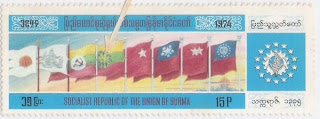The British Parliament passed the India Independence Act which received the Royal assent on July 18, 1947. India was partitioned with the creation of two independent dominions of "Pakistan" on 14 August 1947 and "India" on 15 August 1947.
(From the collection of Mr. Gopal Biswas, Kolkata)
On the midnight of August 14-15, 1947 free India’s National flag was hoisted
atop Council House, later renamed Parliament Bhavan.
The flag was presented by Mrs. Hansa Mehta on behalf of the "Flag Presentation committee" consisting of all the women members of the Indian Constituent Assembly as a gift from the women of India.

On August 15,1947 during the Swearing-in-Ceremony at the Viceregal Lodge (renamed ‘Rashtrapati Bhavan’ on Jan 26,1950) as the new Government took the oath, the free India’s flag was hoisted for the first time on the central dome at 10.30 a.m. The personal standard of the Viceroy of India, a Union Jack emblazoned with the Star of India, came down the flagstaff of the Viceroy’s House for the last time on the evening of 14th. August,1947. It is now hung in the Norman Abbey of Romsay, the last Viceroy’s Parish Church.
On the evening of 14th August, 1947, the Union Jack was lowered from the Tower of the Residency, Lucknow . This was the only spot in the British Empire where the Union Jack was never lowered since the day in 1857, the Tower had become the shrine of Imperial India, a symbol of that doughty British ability to hold fast in adversity.

On 15 August 1947, at 6 p.m. the great event of the day
was to take place - the Salutation of the new Dominion flag. This
programme had originally included a ceremonial lowering of the Union
Jack; but when Mountbatten discussed this with Nehru he entirely agreed
that this was a day they(Indians) wanted everybody to be happy, and if
the lowering of the Union Jack in any way offended British
susceptibilities he(Nehru) would certainly see that it did not take
place.....
In the afternoon of August 15, the first public Flag Salutation Ceremony was held near the “War Memorial Arch” later, renamed “India Gate”. As the Prime Minister, unfurled the flag against a clear summer sky, from nowhere a rainbow resembling the colours of the flag appeared on the horizon which startled the crowed that had assembled there. Lord Mountbatten - the last Viceroy and the first Governor General of India in his 17 th. Report dated August 16,1947 submitted to the Crown, mentioned the mysterious sudden appearance of the rainbow. He wrote, “... the three colours Saffron,White and Green on the flag of the new Dominion resembled so much the hues of the Rainbow”.
The commemorative cancellation was specially provided at Red Fort Post Office on 15 August 1972.
Prime Minister Nehru unfurled the national flag for the first time on the ramparts of the Red Fort on 16th. August 1947 at 8.30 a.m. and not on 15th August 1947. This was a great moment in time ever conscious of history, Nehru referred to Netaji Subhas Bose’s call to “Challo Dilli” and his dream to hoist the ‘Flag of Freedom’ atop Delhi’s Red Fort.The National flag was hoisted for the first time on the ramparts of the Red Fort (Lal Quila) on 16th. August 1947 and not on 15th August 1947 as is commonly believed.
The Nizam of Hyderabad declared that Hyderabad will remain a sovereign power and will not join either India or Pakistan after the transfer of power. It was declared in Hyderabad that “...no flag of any foreign state shall be ceremoniously flown in any public meeting nor any salutation of such flag be made”. Any contravention of the ban would be punishable with imprisonment and fine or both. Swami Ramanand Teerth, the state Congress President demanded that Hyderabad should accede to the Indian Union “..we should not consider the Indian Union flag as that of any foreign state. We wish Hyderabad to be part and parcel of the Indian Union.” Finally, the Indian Tricolour, along with Nizam’s Asafiyah flag, were hoisted atop the Telegraph office of the Indian Government alongside the Residency building at one minute after midnight on 15th. August,1947.
Md. Ismail Sahib, President of the Madras Provincial Muslim League called upon all Muslims in the province to observe Independence Day on August 15 by hoisting the Tricolour Flag

The 47.5 meter (156 feet) mast at the Fort St. George, Madras (now Chennai) is the tallest flag-mast ever built in India.It was on this Flag-mast the Indian Tricolour was hoisted for the first time in Madras. The historic flag is now in the collection of the Fort Museum.
+of+Picture+005.jpg)
Many Hindus in the newly formed Pakistan (then in two segments West Pakistan and East Pakistan) and Muslims in India flew both the flags of India and Pakistan, side by side, not knowing or unable to decide to which country he or she will ultimately belong to. Even after 63 years, perhaps, the dilemma is still exists amongst many.(East Pakistan became independent and renamed Bangladesh in 1971).

 25 th Anniversary of Independence; 1947-1972
25 th Anniversary of Independence; 1947-1972(Note the two different versions of '50 Anniversary' logo on the stationery)
50 th. Anniversary of Independence - a selection of Philatelic items issued to commemorate the great event.
Urgently wanted Post Mark from Washington, USA


+of+Picture+005.jpg)
+of+Picture+005.jpg)















+of+Picture+004.jpg)
+of+Picture+005.jpg)

























+of+Page+41.jpg)



+of+Page+41.jpg)






+of+scan0004.jpg)




+of+scan0004.jpg)
+of+Page+40.jpg)





col.gif)
